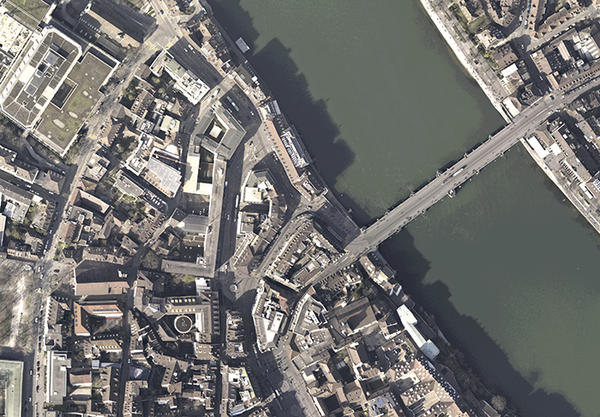1_The Medieval City

Site Schifflände Basel
The transformation of the medieval structure should depart from the very specific historical character of this part of the city and its conditions. Although it represents a large portion of the entire urban entity, the medieval city has today very few inhabitants in relation to its surface, with a density of 271 inhabitants/ha. The medieval centre has been transformed throughout the years into an area dominated by shopping facilities, institutions and offices. Although the old medieval buildings have proved to be capable of being transformed, expanded and modified over the centuries hosting diverse and multiple functions, several buildings or blocks have nonetheless been demolished and reconstructed, especially in the 50s and between 1960 and the 1980 in order to accommodate new functions and to respond to the need of a modernizing society.
These transformations not only represent rapture with the historical built pattern, but also in many cases have altered the spatial qualities inherent to the logic of the dense medieval urban pattern. Through these interventions, the relationship that old buildings establish with the public space and the roads has been lost or compromised.
Following the general premises for the transformation of the city towards a new urban form that would be able to limit its energy consumption, interventions in this part of the city should aim at diversifying present functions by offering primarily living spaces in addition to the dominant existing shopping and working facilities. These living spaces should be compatible with the needs and desire of contemporary inhabitants. Also, social groups that are today excluded by the possibility of living in the historical medieval city centre and that would be attracted by alternative living solutions to those today offered by the standardized housing market should be targeted. As the medieval historical city centre is already an efficient urban form in terms of energy consumption – people move by feet, bike or public transport and building density is here high – the goal of any intervention would be the attempt to improve this condition and to make it available to the larger possible amount of inhabitants.
More specifically, within the compact medieval city center of Basel, the project should focus on the area commonly denominated Schifflände, located in proximity of the Mittlere Rheinbrucke and that stretches in between the Eisengasse, the Marktgasse and the Spiegelgasse. The position of this site, next to the Rhine shore, makes it one of the most attractive of the entire city center yet it is also one of those portions of the historical city where the demolitions and reconstructions have occurred in a rather brutal way, erasing some of the urban qualities inherent to this dense urban pattern. By confronting the several historical views and maps of Basel from different time, it is clear how the process of transformation has here resulted in a ‘rationalization’ and erasure of some of the most interesting public/open spaces of the city, as clearly revealed by the now destroyed Blumenplatz that would today be located in front of the Trois Rois hotel.
Interventions should therefore focus on the area of Schifflände, looking at current buildings, streets and open spaces along and between the Eisengasse, the Marktgasse, the Spiegelgasse up to the Marktplatz and advance proposals that would rethink this portion of the city following the premises enunciated above. Interventions should follow different trajectories and should clearly offer alternative ways to intervene in historical conditions beyond conservative approaches. Starting from the assessment of the current housing stocks and its eventual proposed demolition, projects could be based on the historical critical reconstruction of this portion of the city through the understanding of the occurred topological transformations of the site and the reconstruction of a lost urban form; on the simulation of the past through new architectural interpretations; on the injection of punctual different architecture as during the 19th century; or, alternatively, on a series of strategic interventions on the public spaces or on the transformation of the existing buildings without their demolition.
Moreover, as Schifflände is today characterized by the passage of many tram lines, interventions should reassess the presence of infrastructures on the site and specifically the future need of a new
S-bahn line station.
Student Projects
Project by Julian Oggier and Joshua Brägger
Project by Paul Frickly and Nike Himmels

